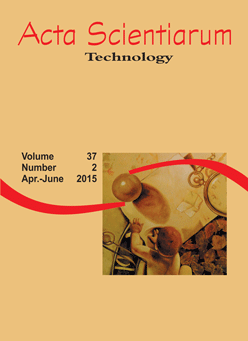<b>Study of sequential disinfection for the inactivation of protozoa and indicator microorganisms in wastewater
DOI:
https://doi.org/10.4025/actascitechnol.v37i2.24950Palavras-chave:
Chlorine, Ultraviolet radiation, Giardia, Clostridium perfringens, Total coliforms, Synergism.Resumo
Sewage disinfection has the primary objective of inactivating pathogenic organisms to prevent the dissemination of waterborne diseases. This study analyzed individual disinfection, with chlorine and ultraviolet radiation, and sequential disinfection (chlorine-UV radiation). The tests were conducted with anaerobic effluent in batch, in laboratory scale, with two dosages of chlorine (10 and 20 mg L-1) and UV (2.5 and 6.1 Wh m-3). In addition, to guarantee the presence of cysts in the tests, 104 cysts per liter of Giardia spp. were inoculated. The resistance order was as follows: E. coli = Total Coliforms < Clostridium perfringens < Giardia spp.. Furthermore, synergistic effects reached 0.06 to 1.42 log of inactivation in sequential disinfection for both the most resistant microorganisms.
Â
Downloads
Downloads
Publicado
Como Citar
Edição
Seção
Licença
DECLARAÇíO DE ORIGINALIDADE E DIREITOS AUTORAIS
Declaro que o presente artigo é original, não tendo sido submetido í publicação em qualquer outro periódico nacional ou internacional, quer seja em parte ou em sua totalidade.
Os direitos autorais pertencem exclusivamente aos autores. Os direitos de licenciamento utilizados pelo periódico é a licença Creative Commons Attribution 4.0 (CC BY 4.0): são permitidos o compartilhamento (cópia e distribuição do material em qualqer meio ou formato) e adaptação (remix, transformação e criação de material a partir do conteúdo assim licenciado para quaisquer fins, inclusive comerciais.
Recomenda-se a leitura desse link para maiores informações sobre o tema: fornecimento de créditos e referências de forma correta, entre outros detalhes cruciais para uso adequado do material licenciado.















